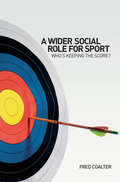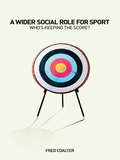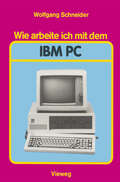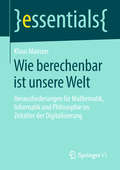- Table View
- List View
The Widening Gap: Why America's Working Families Are In Jeopardy And What Can Be Done About It
by Jody HeymannThis hard-hitting book draws on the first systematic national research on how the need to meet family obligations is affecting working Americans of all social classes and ethnic groups. What happens when kids get sick? When an elderly parent is hospitalized? How do poor families cope with work-family demands? Jody Heymann's research points to a widening gap between working families and the health and development of children. Outdated labor policy and practice must be brought into the twenty-first century, argues Heymann. To do less is to abandon the precepts of equal opportunity on which America is founded.
Widening Participation, Higher Education and Non-Traditional Students: Supporting Transitions through Foundation Programmes
by Catherine A. Marshall Sam J. Nolan Douglas P. NewtonThis book highlights the problems that have developed as students lack either the social or cultural capital to take the opportunity of Higher Education through conventional routes. This might be due to leaving school early, lacking entry qualifications or wanting to further their education and prospects after entering the workplace. Foundation courses help to widen participation and create a route towards higher education. This book offers tried and tested practical solutions, from the notion of widening participation, to recruitment of students and to ways of helping them to make the most of themselves and develop the skills they need to progress on degree courses of their choice.
Widening Participation in Higher Education: Casting the Net Wide? (Issues in Higher Education)
by Tamsin Hinton-SmithThis collection offers an authoritative, up-to-date commentary on the challenges facing higher education today across both the UK and internationally. The book charts the impact of global economic trends and recent policy developments for students, academics, providers and changing course provision.
Widening Scripts: Cultivating Feminist Care in Academic Labor
by Mariana Prandini Assis Michelle Forrest Angela Henderson Lindsey MacCallum Ian Reilly Ellen Shaffner Scott StonemanWidening Scripts: Cultivating Feminist Care in Academic Labor is addressed to scholars, educators, and students devoted to the struggle against precarity, atomization, and the commodification of knowledge. Through shared reading, discussion, and reflection, and gathered around a shared interest in feminist theory and politics, the authors discovered a model of care within academia that helped them to sustain their opposition to dominant academic practices that are diminishing, competitive, and exploitative. In this book, the authors narrate that discovery and the realization of a desire to share in the assembling of a collective feminist survival kit. In Living a Feminist Life, Sara Ahmed offers a wide-ranging killjoy survival kit that includes books, things, tools, time, life, permission notes, other killjoys, humor, feelings, and bodies. As a response to the stress, strain, and profound grief produced by the COVID-19 pandemic, with its viral acceleration of crises already endemic to neoliberal capitalism, the authors mined an evolving cluster of decolonial feminist texts in an attempt to find meaning, encounter moving premonitions, and engage with radical instigations to thought. By co-creating a survival kit through sustained collaboration during the pandemic, they develop a sense of the value of experimentation and risk-taking and learn how to cultivate an inclusive space that allows them to express their views, reclaim accountability, and learn confidently from each other. Widening Scripts combines collaborative feminist theory, acts of care, and critical dialogue in an effort to open up decelerated, altruistic, and connected ways of doing academic work together.
Widening the Circle: Culturally Relevant Pedagogy for American Indian Children
by Beverly J. Klug Patricia T. WhitfieldRecognizing the need for a pedagogy that better serves American Indian students, Beverly J. Klug and Patricia T. Whitfield construct a pedagogical model that blends native and non-native worldviews and methods. Among the building blocks of this new, culturally relevant education are language-based approaches to literacy development, the use of oral histories to supplement traditional texts, and a re-evaluation of the knowledge base these students need for success in tribal enterprises.
Widening the Circle: Culturally Relevant Pedagogy for American Indian Children
by Beverly J. Klug Patricia T. WhitfieldRecognizing the need for a pedagogy that better serves American Indian students, Beverly J. Klug and Patricia T. Whitfield construct a pedagogical model that blends native and non-native worldviews and methods. Among the building blocks of this new, culturally relevant education are language-based approaches to literacy development, the use of oral histories to supplement traditional texts, and a re-evaluation of the knowledge base these students need for success in tribal enterprises.
Widening the Frame with Visual Psychological Anthropology: Perspectives on Trauma, Gendered Violence, and Stigma in Indonesia (Culture, Mind, and Society)
by Annie Tucker Robert LemelsonThis book uses visual psychological anthropology to explore trauma, gendered violence, and stigma through a discussion of three ethnographic films set in Indonesia: 40 Years of Silence (Lemelson 2009), Bitter Honey (Lemelson 2015), and Standing on the Edge of a Thorn (Lemelson 2012). This exploration “widens the frame” in two senses. First, it offers an integrative analysis that connects the discrete topics and theoretical concerns of each film to crosscutting themes in Indonesian history, society, and culture. Additionally, it sheds light on all that falls outside the literal frame of the screen, including the films’ origins; psychocultural and interpersonal dynamics and constraints of deep, ongoing collaborations in the field; narrative and emotional orientations toward editing; participants’ relationship to their screened image; the life of the films after release; and the ethics of each stage of filmmaking. In doing so, the authors widen the frame for psychological anthropology as well, advocating for film as a crucial point of engagement for academic audiences and for translational purposes.Rich with critical insights and reflections on ethnographic filmmaking, this book will appeal to both scholars and students of visual anthropology, psychological anthropology, and ethnographic methods. It also serves as an engrossing companion to three contemporary ethnographic films.
A Wider Social Role for Sport: Who's Keeping the Score?
by Fred CoalterSport is perceived to have the potential to alleviate a variety of social problems and generally to ‘improve’ both individuals and the communities in which they live. Sport is promoted as a relatively cost effective antidote to a range of social problems – often those stemming from social exclusion - including poor health, high crime levels, drug abuse and persistent youth offending, educational under-achievement, lack of social cohesion and community identity and economic decline. To this end, there is increasing governmental interest in what has become known as ‘sport for good’. A Wider Social Role for Sport presents the political and historical context for this increased government interest in sport’s potential contribution to a range of social problems. The book explores the particular social problems that governments seek to address through sport, and examines the nature and extent of the evidence for sport’s positive role. It illustrates that, in an era of evidence-based policy-making, the cumulative evidence base for many of these claims is relatively weak, in part because such research is faced with substantial methodological problems in isolating the precise contribution of sport in many contexts. Drawing on worldwide research, A Wider Social Role for Sport explores the current state of knowledge and understanding of the presumed impacts of sport and suggests that we need to adopt a different approach to research and evaluation if sports researchers are to develop their understanding and make a substantial contribution to sports policy..
A Wider Social Role for Sport: Who's Keeping the Score?
by Fred CoalterSport is perceived to have the potential to alleviate a variety of social problems and generally to ‘improve’ both individuals and the communities in which they live. Sport is promoted as a relatively cost effective antidote to a range of social problems – often those stemming from social exclusion - including poor health, high crime levels, drug abuse and persistent youth offending, educational under-achievement, lack of social cohesion and community identity and economic decline. To this end, there is increasing governmental interest in what has become known as ‘sport for good’. A Wider Social Role for Sport presents the political and historical context for this increased government interest in sport’s potential contribution to a range of social problems. The book explores the particular social problems that governments seek to address through sport, and examines the nature and extent of the evidence for sport’s positive role. It illustrates that, in an era of evidence-based policy-making, the cumulative evidence base for many of these claims is relatively weak, in part because such research is faced with substantial methodological problems in isolating the precise contribution of sport in many contexts. Drawing on worldwide research, A Wider Social Role for Sport explores the current state of knowledge and understanding of the presumed impacts of sport and suggests that we need to adopt a different approach to research and evaluation if sports researchers are to develop their understanding and make a substantial contribution to sports policy..
Widerstand als Ästhetik: Peter Weiss und Die Ästhetik des Widerstands (Literaturwissenschaft / Kulturwissenschaft)
by Karen Hvidtfeldt MadsenIm ersten Teil der Arbeit ordnet Karen Hvidtfeldt Madsen Peter Weiss in das Kunst- und Kulturleben des 20. Jahrhunderts ein und weist dabei besonders auf die Dialektik zwischen Heimatlosigkeit und Zugehörigkeit zur deutschen Kultur hin. Im zweiten Teil interpretiert sie sowohl Form als auch Inhalt der Romantrilogie "Die Ästhetik des Widerstands".
Widerstand Als Selbstbehauptung: »gefährdete« Jugendliche Im Übergangs- Und Berufsbildungssystem (Gesellschaft Der Unterschiede Ser. #72)
by Luca PreiteWiderstand im Arbeitsprozess: Eine arbeitssoziologische Einführung (Arbeit und Organisation #11)
by Heiner Heiland Simon SchauppHerrschaft bringt immer auch Widerständigkeit hervor. Demnach stellen Regelabweichungen, die sich aus unvollständig determiniertem Arbeitshandeln ergeben, ein strukturelles Merkmal im Arbeitsprozess dar. Die Formierung eines informellen Repertoires widerständiger Praktiken im Kontext betrieblicher Herrschaft ist dabei von der Arbeitssoziologie bisher vernachlässigt worden. Um diese konzeptionelle Leerstelle zu füllen, systematisieren die Beiträger*innen die Vielzahl der Praktiken und stellen verschiedene methodische, theoretische und empirische Perspektiven einer arbeitssoziologischen Widerstandsforschung vor.
Widerstand im Arbeitsprozess: Eine arbeitssoziologische Einführung (Arbeit und Organisation #11)
by Simon Schaupp Heiner HeilandHerrschaft bringt immer auch Widerständigkeit hervor. Demnach stellen Regelabweichungen, die sich aus unvollständig determiniertem Arbeitshandeln ergeben, ein strukturelles Merkmal im Arbeitsprozess dar. Die Formierung eines informellen Repertoires widerständiger Praktiken im Kontext betrieblicher Herrschaft ist dabei von der Arbeitssoziologie bisher vernachlässigt worden. Um diese konzeptionelle Leerstelle zu füllen, systematisieren die Beiträger*innen die Vielzahl der Praktiken und stellen verschiedene methodische, theoretische und empirische Perspektiven einer arbeitssoziologischen Widerstandsforschung vor.
Widerstand in Organisationen • Organisationen im Widerstand: Virtuelle Plattformen, Edupunks und der nachfolgende Staat (Organisation und Gesellschaft)
by Ayad Al-AniDie bereits in der ersten Auflage entwickelte These – dass sich Individuen in Wirtschaft und Politik zunehmend selbst organisieren und dass gleichzeitig traditionelle Institutionen diese Formen der individualisierten, selbstgesteuerten Kollaboration nutzen, um innovativ zu bleiben – kann anhand aktueller Beispiele aus Wirtschaft und Politik nachgewiesen werden. Der Band thematisiert die Funktionsweisen dieser neuen Peer-to-Peer Kollaborationen, die zumeist virtuelle Plattformen als Organisationselement verwenden und besser als die Hierarchie Individualität nutzen können. Die Annäherung zwischen traditionellen Organisationen und vernetzten Kollaborationen nimmt unter Schlagwörtern wie Open Government, Open Innovation und Crowdsourcing merklich zu, es entstehen hybride Organisationen, Netarchien. Zugleich kommt es zu einer Kommerzialisierung der ursprünglich auf intrinsischer Motivation aufgebauten Selbstorganisation durch Unternehmer, die mit diesem Modell traditionelle Mitbewerber angreifen können. Parallel entsteht ein neues Verständnis des Staates, der zu einem Partner selbstgesteuerter Kollaborationen seiner Bürger wird und diese verwendet, um Leistungen zu erbringen, die der Staat selbst nicht mehr leisten kann.
Widerstand in Organisationen • Organisationen im Widerstand - Revisited: Plattformen, Edupunks und die Free Crowd (Organisation und Gesellschaft)
by Ayad Al-AniDie hier vorgestellten Alternativen zur traditionellen Hierarchie, die Anfang des Jahrtausends zum ersten Mal die Bühne betraten und zunächst in der Open-Source-Bewegung und dann auf kommerziellen Crowdplattformen ihren Siegeszug antraten, haben sich im Laufe kurzer Zeit verändert. Konnte man Anfang des Jahrtausends noch hoffen, dass ein Wirtschaftssektor entsteht, der hierarchieärmer, ethischer und partizipativer ist, so musste man nach der Finanzkrise feststellen, dass derartige Organisationsformen oft Teil eines pulsierenden Kapitalismus waren, welcher auch fremdartige Konzepte sporadisch nutzt, um auf Krisen zu reagieren. Auch von der Idee, dass die Digitalisierung die Demokratie beflügeln könnte, ist wenig übriggeblieben. Allerdings haben die nun entstandenen technologischen Plattformen einen massiven Nebeneffekt. Die hier gesammelten Daten gaben der Automatisierung einen neuen Schub. Die Flucht aus der Hierarchie, die in den ersten beiden Ausgaben skizziert wurde, wird also weiter gehen. Es sind nun die Konturen technologiebasierter Communities erkennbar, welche Heimat einer „Freien Crowd“ sind und ergänzend zu den bestehenden Nationen mehr Gewicht erlangen können.
Widerstand in Organisationen. Organisationen im Widerstand: Virtuelle Plattformen, Edupunks und der nachfolgende Staat (Organisation und Gesellschaft)
by Ayad Al-AniDie Zeit scheint reif für eine neue Bewertung des Individuums in Organisationen. Neue Technologien und globalisierte Rahmenbedingungen verlangen äußerst kreative Anstrengungen im Rahmen von Freiräumen, die die neuen netzwerkartigen Organisationsformen nun erstmals ermöglichen. Geläufige Management- und Organisationsansätze stehen der Frage, wie Individualität und Führung solcher divergenter Interessen und Talente unter einen Hut zu bringen seien, noch ratlos gegenüber. Dieses Buchprojekt soll skizzieren, wie die vor uns liegende Transformationsphase sowohl auf der Ebene der Organisation und Führung, aber auch in den Sphären der gesellschaftlichen Institutionen, und hier insbesondere im heute schon umkämpften Bildungsbereich, aussehen wird.
Widerständiges Wissen: Herbert Marcuses Protesttheorie in Diskussion mit Intellektuellen der Refugee-Bewegung der 2010er Jahre (Sozialtheorie)
by Lisa DopplerIn den 2010er Jahren gewann die selbstorganisierte Refugee-Bewegung mit Protestmärschen, Besetzungen und der Verhinderung von Abschiebungen an Sichtbarkeit. Eine radikale Kritik wurde ebenso formuliert wie Utopien gesellschaftlicher Transformation. Worauf zielt dieses Bedürfnis nach Befreiung? Welche Organisationsformen schaffen echte Solidarität? Und welcher Protest wird wie in dieser Gesellschaft (re)integriert? Diese Fragen haben auch Herbert Marcuse beschäftigt. Lisa Doppler diskutiert seine Protesttheorie mit organischen Intellektuellen der Refugee-Bewegung. Dabei geht es um die Deutung der Bewegung und darum, Kritische Theorie in der Praxis mit feministischem und dekolonialem Anspruch neu zu erkunden.
Widowhood in an American City
by Helena LopataWidowhood in an American City focuses on the roles and lifestyles of urban American widows fifty years of age or older. These women form a segment of two generations of one society; they present a historical instance of people born and brought up under conditions that are not likely to be duplicated. Not only the U.S., but many other countries are undergoing modifications in the degrees and forms of urbanization, industrialization, and social complexity.Helena Znaniecki Lopata argues that the way women re-engage society following the death of a husband is different due to their location in the modern social system. She notes that the trends in social structure are toward increasingly voluntaristic engagement in achieved, functionally oriented social roles that are performed in large groups and contain secondary social relations. The cultural background of many societal members prevents the utilization of most resources of the complex urban world, restricting them to a small social life space, with almost automatically prescribed social relations.Those who argue that the elderly are socially isolated contend that this is a result of the natural process of withdrawal of the person and the society from each other. These arguments focus on those who are isolated or lonely and those who lack the skills, money, health, and transportation for engaging or re-engaging society. Lopata's study indicates that this assumption is false for many widows. If such people are to be helped, a fresh view of the relation between the urban, industrial, and complex modern world and its residents is required, and new action programs must be creatively developed. This is a timely, ground-breaking work that addresses and shatters common myths associated with growing old alone in an urban society.
Widowhood in an American City
by Helena LopataWidowhood in an American City focuses on the roles and lifestyles of urban American widows fifty years of age or older. These women form a segment of two generations of one society; they present a historical instance of people born and brought up under conditions that are not likely to be duplicated. Not only the U.S., but many other countries are undergoing modifications in the degrees and forms of urbanization, industrialization, and social complexity.Helena Znaniecki Lopata argues that the way women re-engage society following the death of a husband is different due to their location in the modern social system. She notes that the trends in social structure are toward increasingly voluntaristic engagement in achieved, functionally oriented social roles that are performed in large groups and contain secondary social relations. The cultural background of many societal members prevents the utilization of most resources of the complex urban world, restricting them to a small social life space, with almost automatically prescribed social relations.Those who argue that the elderly are socially isolated contend that this is a result of the natural process of withdrawal of the person and the society from each other. These arguments focus on those who are isolated or lonely and those who lack the skills, money, health, and transportation for engaging or re-engaging society. Lopata's study indicates that this assumption is false for many widows. If such people are to be helped, a fresh view of the relation between the urban, industrial, and complex modern world and its residents is required, and new action programs must be creatively developed. This is a timely, ground-breaking work that addresses and shatters common myths associated with growing old alone in an urban society.
Widows of Vidarbha: Making of Shadows
by Kota NeelimaVidarbha—the parched heartland of central India—has become the foremost site of farmer suicides in the country. These suicides are the most striking indictment of the neglect of agriculture by the state. But the story of the farmers’ distress does not end with their death—it lives on in the experience of their widows who struggle to survive in the shadows. Widows of Vidarbha tells the story of 16 such widows who have been invisible to the state, the community, and even their families, and talks of their lost dreams, their diminished worldviews, and their helpless surrender to the conveniences of patriarchy. These narratives throw light on the dark and desperate corners of their invisible world, one that reflects the state of farm widows across the country.
Wie aus Wildnis Gesellschaft wird: Kulturelle Selbstverständigung und populäre Kultur am Beispiel von John Fords Film "The Man Who Shot Liberty Valance"
by Jörn AhrensDas Buch untersucht John Fords klassischen Western „The man who shot Liberty Valance“, der wie kaum ein anderer soziologische Fragestellungen behandelt: Wie ist Gesellschaft möglich? Unter welchen Voraussetzungen findet Vergesellschaftung statt? Der Band zeigt, wie sehr sich kulturelle Artefakte für eine kultursoziologische Analyse der Gesellschaft eignen und Aussagen treffen, die zum Verständnis kultureller Prozesse beitragen können. Zugleich wird deutlich, wie stark Kulturprodukte einerseits selbst in soziale Diskurse und Traditionsbildungen eingebunden sind und sie andererseits ein spezifisches Wissen über Kultur und Gesellschaft beinhalten.
Wie berechenbar ist unsere Welt: Herausforderungen für Mathematik, Informatik und Philosophie im Zeitalter der Digitalisierung (essentials)
by Klaus MainzerKlaus Mainzer legt in diesem essential dar, dass die Zukunft von KI und Digitalisierung eine nüchterne Analyse erfordert, die Grundlagenforschung mit Anwendung verbindet. Berechenbarkeits- und Beweistheorie können dazu beitragen, Big Data und Machine Learning sicherer zu bewältigen. Dabei zeigt sich, dass die komplexen Herausforderungen der digitalen und analogen Welt in Grundlagenfragen der Mathematik, Informatik und Philosophie tief verwurzelt sind.
Wie das Fernsehen den Krieg gewann: Zur Medienästhetik des Krieges in der TV-Serie (Serienkulturen: Analyse – Kritik – Bedeutung)
by Ivo RitzerDiese Studie verfolgt eine Synthese von medienästhetischer und diskursanalytischer Perspektive. Dabei wird das Genre der TV-Kriegsserie als eine symbolische Form verstanden, durch die eine Gesellschaft über sich selbst reflektiert, indem sie ihre Vergangenheit in Bildern wie Tönen reimaginiert. Kriegshistorie wird dadurch als generisch strukturierte Narration vergangener Ereignisse lesbar, die in der und für die Gegenwart einer neuen Lektüre unterzogen ist. Der Untersuchung ästhetischer Verfasstheiten im Genre der TV-Kriegsserie steht deshalb eine Analyse jener diskursiven Bedingungen gegenüber, die im soziokulturellen Rahmen eine Kommunikationsfunktion der Kriegsserie erst hervorbringen. Dieser Band will deshalb auch keine Geschichte der TV-Kriegsserie erzählen, vielmehr konzentriert er sich auf spezifische Mechanismen der sinnlichen wie sinnhaften Erscheinung von Kriegsnarrativen im Kontext der Fernsehserie.
Wie der Staat trauert: Zivilreligionspolitik in der Bundesrepublik Deutschland (Staat – Souveränität – Nation)
by Stefanie HammerDer Begriff Zivilreligionspolitik fokussiert die prozessuale Politikdimension und beschreibt politische Deutungsangebote, bei denen symbolisch ‚religiöse‘ Vorstellungen repräsentiert werden, um so die Legitimation politischer Projekte sowie die normative Integration in politischen Gemeinschaften voranzutreiben. Ideengeschichtlich ist der Begriff auf Jean Jacques Rousseau zurückzuführen. In seiner Vertragstheorie formuliert dieser ein obligatorisches bürgerliches Glaubensbekenntnis, seine „religion civile“. Die sozialwissenschaftliche Debatte um Zivilreligion, mit Beiträgen von Robert N. Bellah, Niklas Luhmann, Hermann Lübbe und Wolfgang Vögele, konzentrierte sich bisher auf die inhaltliche Dimension. Die performative Wirkungsmächtigkeit zivilreligiöser Rituale zum Zwecke der normativen Integration politischer Gemeinschaften wurde dagegen theoretisch vernachlässigt und symbolische Politik im Allgemeinen und politische Rituale im Besonderen als täuschende Inszenierung kritisiert. Ausgehend vom Konzept der Zivilreligionspolitik werden schließlich die zentralen Trauerfeiern für die gefallenen Soldaten untersucht.



















